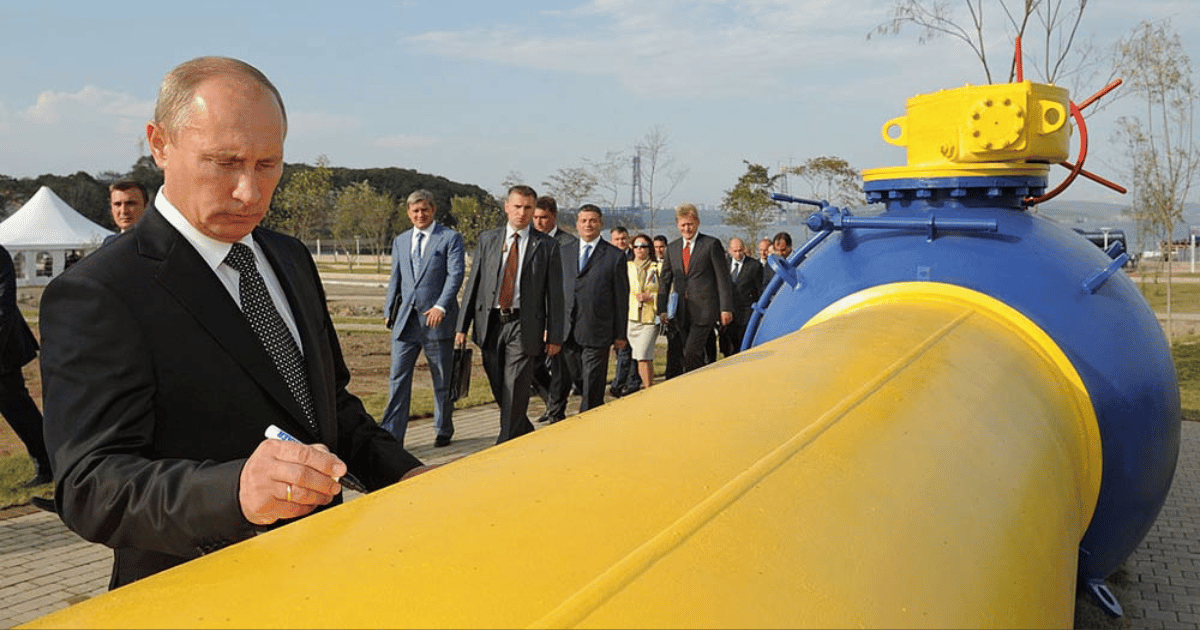In recent times, the European Union (EU) has been diligently working towards reducing its dependency on Russian fossil fuels, a pivotal move aimed at enhancing energy security and sustainability.
The EU Commission President’s bold assertion about breaking free from this dependence, accompanied by significant strides in investing in renewable energies, suggests a transformative shift in the EU’s energy landscape. However, the reality, as of October 2023, paints a more nuanced picture. Despite notable progress, the EU has not entirely severed its ties with Russian fuel sources.
This article delves into the recent developments, examining the data and expert opinions that shed light on the extent of the EU’s accomplishment in this critical energy transition. It explores the challenges faced and the prospects ahead, aiming to provide a comprehensive view of the EU’s journey towards energy independence and sustainability.
I. The EU’s Historic Dependence on Russian Fuel
For years, the EU has been deeply reliant on imports of fossil fuels, particularly natural gas, from Russia. The following statistics highlight the magnitude of this dependency:
Natural Gas Dependency: In 2021, Russia was the largest exporter of natural gas to the EU, accounting for a significant 40% of the gas consumed in the union. This heavy reliance posed a considerable challenge for the EU in terms of energy security and geopolitical vulnerability.
Oil Import Dominance: Russia was also a major supplier of oil to the EU, providing approximately 90% of the oil imported in 2021. This high level of dependence made the EU susceptible to any disruption in Russian oil supply.
Weaponization of Gas Supplies: Russia’s history of using gas supplies as a geopolitical tool and the political tension between the EU and Russia further complicated the energy relationship.
Nord Stream Pipeline Sabotage: The sabotage of the Nord Stream pipelines, which transport Russian gas to Europe, added to the concerns of the EU regarding the reliability of Russian gas supplies.
The European Union has made notable progress in reducing its reliance on Russian fossil fuels. The complex interplay of geopolitical tensions, energy security concerns, and environmental objectives has driven the EU to diversify its energy sources and limit its exposure to Russia's energy supplies. While challenges remain, including the increase in LNG imports, the EU's commitment to renewable energy, and the establishment of the Task Force for Energy Security, signals a resolute effort to achieve energy independence and security.
II. Recent Developments and Geopolitical Tensions
In 2022, a series of developments and decisions from both the EU and Russia significantly impacted the EU’s reliance on Russian fuel sources. These factors played a crucial role in diversifying energy supplies:
Reduced Russian Gas Deliveries: In 2022, Russia delivered only around 60 billion cubic meters (BCM) of gas to the EU, compared to 155 BCM in 2021. This drastic reduction in gas deliveries was partially a result of EU sanctions and other external factors.
The European Commission’s Ban on Oil Imports: In response to the 2022 Russian invasion of Ukraine, the European Commission proposed a ban on oil imports from Russia, further signaling the EU’s intent to reduce its dependence on Russian energy.
Kremlin-Imposed Changes: Moscow imposed changes in rules around gas supplies for European customers and suspended gas transport via the Nord Stream 1 pipeline. These decisions, while not directly initiated by the EU, contributed to the diversification of energy sources.
Increased LNG Imports: The EU made substantial strides in diversifying its gas imports, including a 60% increase in liquefied natural gas (LNG) imports. This diversification came not only from non-Russian sources but also included Russian LNG.
III. EU’s Diversification Efforts
The EU has been actively pursuing diversification strategies to reduce its reliance on Russian fossil fuels. These efforts have yielded substantial progress, including:
Pipelines from Azerbaijan and Norway: The EU increased its gas imports via pipelines from countries like Azerbaijan and Norway, strengthening its energy security.
The 10-Point Plan: A suite of measures within the 10-Point Plan, spanning gas supplies, the electricity system, and end-use sectors, is expected to reduce the EU’s annual call on Russian gas imports by over 50 BCM within a year. This includes strategies to lower emissions and promote sustainable energy practices.
Future Outlook: It is estimated that within 25 years, up to 80% of the EU’s natural gas will be imported, with Russia potentially providing around 60% of this share.
IV. Challenges and Recent Trends
Despite the EU’s proactive efforts to reduce its reliance on Russian fossil fuels, several challenges and recent trends must be considered:
LNG Imports Increase: EU countries have increased their imports of LNG from Russia, particularly after the Ukraine crisis, with a 40% increase in the first seven months of 2023 compared to 2021. However, it is essential to note that these volumes are still relatively minor compared to pipeline gas imports from Russia.
Diversifying Oil Suppliers: Some EU countries have offset the loss of Russian crude oil by increasing imports from other regions, including the Middle East, West Africa, Norway, and Kazakhstan. This strategy has helped mitigate the impact of the oil import ban from Russia.
Renewable Energy and Energy Savings: The EU is actively focusing on renewable energy and energy savings as part of the REPowerEU campaign. By 2030, this campaign aims to provide more than 40% of the EU’s total power from renewable sources.
V. The Role of the Task Force for Energy Security
The joint Task Force for Energy Security, established by President Joe Biden and European Commission President Ursula von der Leyen in 2022, plays a pivotal role in reducing Europe’s dependence on Russian fossil fuels. This initiative focuses on various aspects:
Support for Ukraine: The Task Force works to ensure energy security for Ukraine and the EU, particularly during the winter months, while supporting Ukraine’s energy independence.
EU’s 2027 Pledge: The European Commission’s vow to end its reliance on Russian fossil fuels by 2027 is a significant commitment that is being actively pursued through these initiatives.
Urging Non-Engagement with Russian LNG: EU energy commissioner Kadri Simson’s call to member states and companies to stop buying Russian LNG and not sign new gas contracts with Russia after existing contracts expire is a clear signal of the EU’s intent.
VI. Ursula von der Leyen’s Declaration and the Role of Renewable Energy
President von der Leyen’s declaration in September 2022 that the EU had stopped importing Russian coal and diversified away from Russian fossil fuels reflects a significant shift in the EU’s energy policies. The focus on renewable energy, reducing energy consumption, and diversifying energy sources through the REPowerEU campaign is a key component of this strategy.
Here is a table of EU countries that are still importing Russian fuel and the type of fuel they imported according to the available data:
| Country | Type of Fuel | Amount of Fuel Imported |
| EU | Crude Oil, Natural Gas | $18.4 billion so far in 2023 |
| Germany | Natural Gas | 83.3 billion cubic meters in 2021 |
| Italy | Natural Gas | 29.5 billion cubic meters in 2021 |
| Turkey | Natural Gas, Coal | $12.1 billion up until June 16, 2023 |
| France | Natural Gas | 21.5 billion cubic meters in 2021 |
| Austria | Natural Gas | 9.3 billion cubic meters in 2021 |
| Greece | Natural Gas | 3.6 billion cubic meters in 2021 |
| Hungary | Natural Gas | 8.1 billion cubic meters in 2021 |
| Poland | Natural Gas | 13.3 billion cubic meters in 2021 |
| Slovakia | Natural Gas | 5.8 billion cubic meters in 2021 |
| Czech Republic | Natural Gas | 8.4 billion cubic meters in 2021 |
Germany is the largest importer of Russian natural gas in the EU, followed by Italy, Turkey, and France. Turkey is the only EU candidate country that is still importing Russian coal. The EU as a whole has been reducing its dependence on Russian fossil fuels, and the European Commission has vowed to quit Russian fossil fuels by 2027. The EU has been diversifying its gas suppliers to reduce its dependence on Russia, including increasing gas imports via pipelines from Azerbaijan and Norway. The EU has also been boosting the use of renewable energy, reducing overall energy consumption, and diversifying energy sources through the REPowerEU campaign.
As the EU continues to pursue its goal of eliminating its dependence on Russian fuel sources by 2027, it will navigate an evolving energy landscape and work towards ensuring a stable, diverse, and sustainable energy future for its member states. The road ahead is challenging, but the EU’s determination to reduce its reliance on Russian fuel is evident in the multifaceted strategies and actions being taken to secure its energy future.






